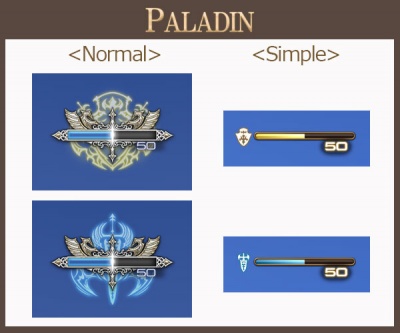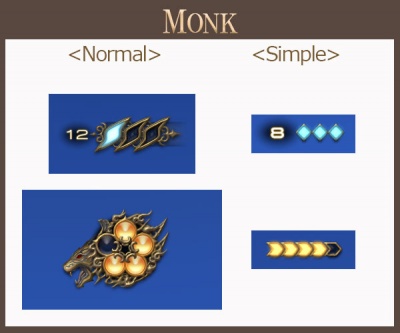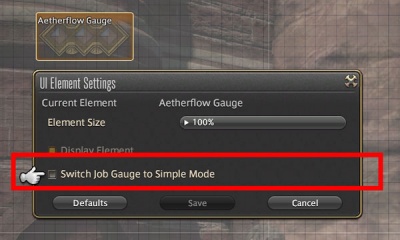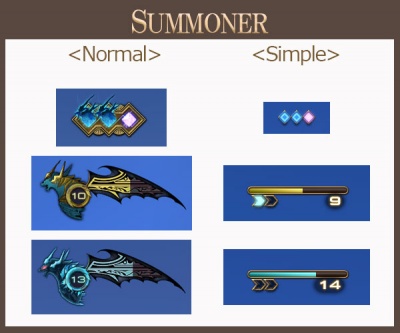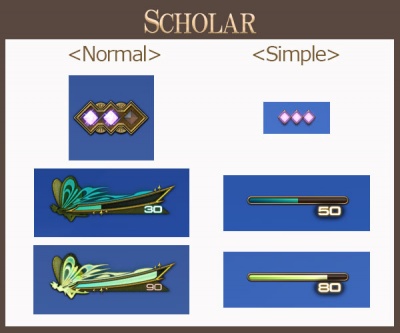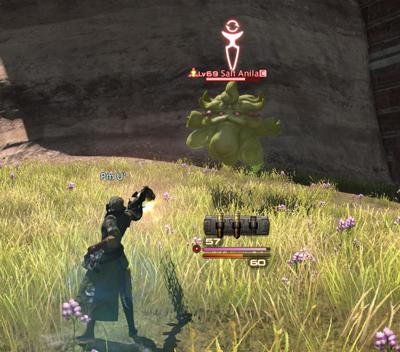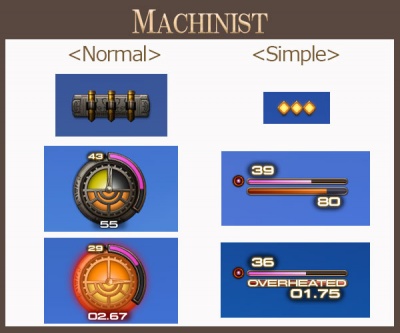Difference between revisions of "Job Gauge"
| Line 73: | Line 73: | ||
=== [[White Mage]] === | === [[White Mage]] === | ||
Every 30 seconds in combat a White Mage will gain a Lily; they may hold up to 3 at any time. Lilies can be spent on the spells [[Afflatus Solace]], and [[Afflatus Rapture]]. After using 3 Lilies, the White Mage will have nourished the Blood Lily, allowing them to cast [[Afflatus Misery]]. | |||
=== [[Scholar]] === | === [[Scholar]] === | ||
Revision as of 23:16, 9 July 2019
Introduction
In Stormblood (4.0), with the new combat class redesigns, the new UI element Job Gauge is added for each individual battle class. The Job Gauge includes useful information for each class, primarily on resource management. For example, a percentage meter out of 100 is shown for Paladin, Warrior, Dark Knight, Scholar, Dragoon, Ninja, Samurai, Machinist, and Red Mage. Those can be used for different things.
Simple Job Gauge
The simplified job gauge, released in patch 4.1, is basically exactly what it sounds like: a simplified version of the current job gauge, minimizing the design elements while retaining the information such as stacks and other values.
- The information displayed is the same on both the normal and simple version. You won't lose anything by choosing one or the other.
- Color format follows the normal job gauges.
Here's an example of the paladin Oath Gauge that showcases the normal job gauge and the simple job gauge.
The display is similar to the HP/MP bar, and the color display will be shown according to your current stance. This applied for all three tank jobs gauges.
Moving on, here's an example of what a stacking-type gauge looks like (monk's Greased Lightning and Chakra).
Switching between Normal/Simple Modes
You can switch between the normal and simple versions of the job gauge display through the individual HUD layout options.
- You'll need to be on the job you want to change your job gauge.
You can also switch between the two versions using the following text command:
/jobhudmode
If there are two job gauges available, assign a number to switch the specific job gauge display:
/jobhudmode [number]
And for jobs that have more than one gauge, you'll still be able to use the text command by adding a "1" or "2". Using the summoner's job gauge as an example:
/jobhudmode 1 will change the Aetherflow Gauge, and
/jobhudmode 2 will change the Trance Gauge.
For scholar, job gauge 1 is the Aetherflow Gauge, and 2 is the Faerie Gauge!
Job Gauge Settings and Layout
What if you prefer the simple version for one job, but want the normal gauge on another? Don't fret: you'll be able to save the layout information of normal and simple job gauges per job. Perhaps you'll have a normal display for your black mage, but a simplified version for astrologian. The choice is yours! Jobs with two gauges like summoner and scholar can even choose to have one normal gauge and one simplified. Jobs with two gauges can mix and match as they like!
Check it out, the machinist above has a normal Ammunition Gauge, but is also using the simplified Heat Gauge.
Speaking of machinist, in Patch 4.1 the duration of Hot Shot will now be displayed in the job gauge. This will apply to both the normal and simple version.
Last but not least, the settings for both styles of job gauges can be saved on the HUD layouts 1 through 4 individually, so you can switch between all sorts of modes as you like!
Tanks
All Tank gauges change design to reflect which stance they are using.
Paladin
The Paladin's Oath Gauge is charged by autoattacks (in Sword Oath) or blocking attacks (in Shield Oath). The accumulated Oath can then be consumed to power abilities like Sheltron and Intervention.
Warrior
The Warrior's Beast Gauge reflects the use of Deliverance or Defiance stance, and the Warrior charges it with Wrath via the use of weaponskills, it increases Critical Hit Rate or Parry Rate respectively. Wrath can then be consumed to activate special skills and abilities, such as Fell Cleave.
Dark Knight
The Dark Knight's Blood Gauge initially reflects whether or not Grit is active, and an additional meter is added when the ability to gain Blackblood is earned. This Blackblood is then spent on self-boosts and powerful attacks.
Healers
White Mage
Every 30 seconds in combat a White Mage will gain a Lily; they may hold up to 3 at any time. Lilies can be spent on the spells Afflatus Solace, and Afflatus Rapture. After using 3 Lilies, the White Mage will have nourished the Blood Lily, allowing them to cast Afflatus Misery.
Scholar
The Scholar has two gauges; one for Aetherflow, and one for their Faerie;
- The Aetherflow Gauge tracks accumulated Aether, which is spent to execute certain actions such as Energy Drain.
- The Faerie Gauge tracks Aether accumulated within the Scholar's Faerie, which is increased by executing certain actions (such as Energy Drain) and then consumed by others, most notably Aetherpact.
Astrologian
The Astrologian's Arcana Gauge tracks the currently held card (or arcanum) in the center, reserved cards on the left side, and effects from Royal Road at the top. In addition, an element on the right displays the currently held Minor Arcana.
Melee DPS
Monk
The Monk has two simple gauges;
- The Lightning Gauge tracks the current level and remaining duration of Greased Lightning.
- The Chakra Gauge tracks how many Chakra the monk has opened.
Dragoon
The Dragoon's Dragon Gauge appears when Blood of the Dragon is active, and indicates the remaining time until the effect expires. At higher levels, it also tracks the First Brood's Gaze. Once the Gaze reaches its maximum level, the Dragoon can execute Geirskogul to engage Life of the Dragon, changing the appearance of the Dragon Gauge and allowing use of the Nastrond weaponskill.
Ninja
The Ninja has two relatively simple gauges;
- The Huton Gauge is a simple countdown, tracking the time remaining.
- The Ninki Gauge is slowly built with successful autoattacks, and can be used to power new special abilities such as Hellfrog Medium, Bhavacakra, and Ten Chi Jin.
Samurai
The Samurai has two distinct gauges;
- Initially, they have the Sen 'gauge'. This tracks the three Sen that Samurai can acquire (Setsu, Getsu, and Ka) and their status.
- Later, they gain the Kenki gauge, which resembles a conventional katana. Kenki is gained through executing certain skills or combinations of skills, and can be spent in order to execute special Hissatsu moves, which can enhance the Samurai's next weaponskill to deal more damage, or perform special maneuvers such as a closing charge or short backstep.
Physical Ranged DPS
Bard
The Bard's gauge appears whilst singing Mage's Ballad, Army's Paeon, or The Wanderer's Minuet, and displays a timer that tracks the remaining duration of the song.
In addition, a series of musical notes or arrowheads appear when using Army's Paeon or The Wanderer's Minuet respectively. Whenever certain damage over time skills deal critical damage, these symbols will light up, granting the following effects;
- For each note of Army's Paeon that is lit up, the Bard's weaponskills and spells are cast faster and have shorter recast times, and autoattacks are faster.
- For each note of The Wanderer's Minuet that is lit up, the potency of the new Pitch Perfect skill is increased (up to a maximum of 420).
Machinist
The Machinist has two seperate gauges - one for Ammunition, and one for Heat.
- The Ammunition Gauge simply tracks how many special rounds the Machinist has loaded.
- The Heat Gauge is only available whilst using Gauss Barrel, and pushing the Heat Gauge to maximum causes the Machinist's weapon to overheat. This increases weapon power for a short time, then renders the weapon unusable for a short time. At higher levels, the Machinist has access to special Heated versions of the three basic weaponskills, further increasing damage whilst the Heat Gauge is within a certain range; careful heat management is required for maximum firepower.
Magical Ranged DPS
Black Mage
The Black Mage has a single, multi-part gauge that tracks the following;
- Astral Fire/Umbral Ice status
- Umbral Heart status (gained by casting Blizzard IV)
- Enochian timer and status
- Foul spell readiness
Summoner
The Summoner has two gauges; an Aetherflow Gauge, and later, a Trance Gauge.
- The Aetherflow Gauge tracks Aethertrail Attunement level. When fully charged, the Summoner may enter the Dreadwyrm Trance.
- The Trance Gauge has three functions. First, it tracks Dreadwyrm Aether. Second, it tracks the current duration of the Dreadwyrm Trance. Finally, after summoning Demi-Bahamut, the gauge indicates the remaining time before Demi-Bahamut disappears.
Red Mage
The Red Mage has a single three-part gauge that tracks their accumulated Black Mana and White Mana, along with a small crystal at the top that changes colour when one element becomes too dominant. When both kinds of Mana are charged up, certain melee attacks are Enchanted, and will deal significantly increased damage.


